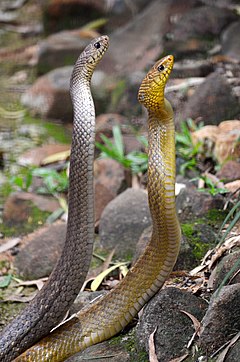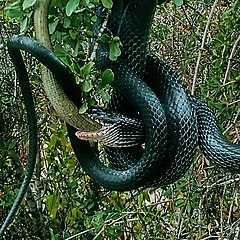Colubridae
| Colubridae Temporal range: [1]
| |
|---|---|

| |
| Colubridae species | |
| Scientific classification | |
| Domain: | Eukaryota |
| Kingdom: | Animalia |
| Phylum: | Chordata |
| Class: | Reptilia |
| Order: | Squamata |
| Suborder: | Serpentes |
| Superfamily: | Colubroidea |
| Family: | Colubridae Oppel, 1811 |
Colubridae (
Description
A primarily shy and harmless group of snakes, the vast majority of colubrids are not
Some colubrids are described as
Classification
In the past, the Colubridae were not a natural group, as many were more closely related to other groups, such as elapids, than to each other.[9] This family was historically used as a "wastebasket taxon"[5] for snakes that do not fit elsewhere.[10] Until recently, colubrids were basically colubroids that were not elapids, viperids, or Atractaspis.[11]
However, recent research in molecular phylogenetics has stabilized the classification of historically "colubrid" snakes and the family as currently defined is a monophyletic clade,[12][13][14][15] although additional research will be necessary to sort out all the relationships within this group. As of May 2018, eight subfamilies are recognized.[16]
Current subfamilies
Sibynophiinae – three genera
- Colubroelaps
- Scaphiodontophis
- Sibynophis

- Afronatrix
- Amphiesma
- Amphiesmoides
- Anoplohydrus
- Aspidura
- Atretium
- Blythia [17]
- Clonophis
- Fowlea
- Haldea
- Hebius
- Helophis
- Herpetoreas
- Hydrablabes
- Hydraethiops
- Iguanognathus
- Isanophis
- Limnophis
- Liodytes
- Natriciteres
- Natrix
- Nerodia
- Opisthotropis
- Pseudagkistrodon
- Regina
- Rhabdophis
- Rhabdops
- Smithophis
- Storeria
- Thamnophis
- Trachischium
- Trimerodytes
- Tropidoclonion
- Tropidonophis
- Virginia
- Xenochrophis
- †Neonatrix
Pseudoxenodontinae – two genera

- Adelphicos
- Adelphostigma
- Alsophis
- Amastridium
- Amnesteophis
- Amnisiophis
- Apographon
- Apostolepis
- Arcanumophis
- Arrhyton
- Atractus
- Baliodryas
- Boiruna
- Borikenophis
- Caaeteboia
- Calamodontophis
- Caraiba
- Carphophis
- Cenaspis
- Cercophis
- Chersodromus
- Chlorosoma
- Clelia
- Coniophanes
- Conophis
- Contia
- Coronelaps
- Crisantophis
- Cryophis
- Cubophis
- Diadophis
- Diaphorolepis
- Dibernardia
- Dipsas
- Ditaxodon
- Drepanoides
- Dryophylax
- Echinanthera
- Elapomorphus
- Emmochliophis
- Enuliophis
- Enulius
- Erythrolamprus
- Eutrachelophis
- Farancia
- Galvarinus
- Geophis
- Gomesophis
- Haitiophis
- Helicops
- Heterodon
- Hydrodynastes
- Hydromorphus
- Hydrops
- Hypsiglena
- Hypsirhynchus
- Ialtris
- Imantodes
- Incaspis
- Leptodeira
- Lioheterophis
- Lygophis
- Magliophis
- Manolepis
- Mesotes
- Mussurana
- Ninia
- Nothopsis
- Omoadiphas
- Oxyrhopus
- Paikwaophis
- †Paleoheterodon
- Paraphimophis
- Phalotris
- Philodryas
- Phimophis
- Plesiodipsas
- Pliocercus
- Pseudalsophis
- Pseudoboa
- Pseudoeryx
- Pseudoleptodeira
- Psomophis
- Ptychophis
- Rhachidelus
- Rhadinaea
- Rhadinella
- Rhadinophanes
- Rodriguesophis
- Saphenophis
- Sibon
- Siphlophis
- Sordellina
- Synophis
- Tachymenis
- Tachymenoides
- Taeniophallus
- Tantalophis
- Thamnodynastes
- Thermophis
- Tomodon
- Tretanorhinus
- Trimetopon
- Tropidodipsas
- Tropidodryas
- Uromacer
- Urotheca
- Xenodon
- Xenopholis
- Xenoxybelis
- Zonateres
Calamariinae – seven genera
Ahaetuliinae – five genera
Colubrinae – 93 genera

- Aeluroglena
- Aprosdoketophis
- Archelaphe
- Arizona
- Bamanophis
- Bogertophis
- Boiga
- Cemophora
- Chapinophis
- Chironius
- Coelognathus
- Coluber
- Conopsis
- Coronella
- Crotaphopeltis
- Dasypeltis
- Dendrophidion
- Dipsadoboa
- Dispholidus
- Dolichophis
- Drymarchon
- Drymobius
- Drymoluber
- Eirenis
- Elaphe
- Euprepiophis
- Ficimia
- Geagras
- Gonyosoma
- Gyalopion
- Hapsidophrys
- Hemerophis
- Hemorrhois
- Hierophis
- Lampropeltis
- Leptodrymus
- Leptophis
- Liopeltis
- Lycodon
- Lytorhynchus
- Macroprotodon
- Masticophis
- Mastigodryas
- Meizodon
- Mopanveldophis
- Muhtarophis
- Oligodon
- Oocatochus
- Opheodrys
- Oreocryptophis
- Orientocoluber
- Oxybelis
- Palusophis
- Pantherophis
- †Paracoluber
- Persiophis
- Philothamnus
- Phrynonax
- Phyllorhynchus
- Pituophis
- Platyceps
- Pseudelaphe
- Pseudoficimia
- Ptyas
- Rhamnophis
- Rhinobothryum
- Rhinocheilus
- Rhynchocalamus
- Salvadora
- Scaphiophis
- Scolecophis
- Senticolis
- Simophis
- Sonora
- Spalerosophis
- Spilotes
- Stegonotus
- Stenorrhina
- Stichophanes
- Symphimus
- Sympholis
- Tantilla
- Tantillita
- Telescopus
- Thelotornis
- Thrasops
- Toxicodryas
- Trimorphodon
- Wallaceophis
- Wallophis
- Xenelaphis
- Xyelodontophis
- Zamenis
- †Zelceophis
Sub-family currently undetermined
- Elapoidis
- Gongylosoma
- Lycognathophis
- Oreocalamus
- Tetralepis
- †Ameiseophis[18]
- †Dryinoides
- †Hispanophis
- †Floridaophis[19]
- †Micronatrix
- †Miocoluber
- †Mionatrix?
- †Palaeonatrix
- †Paleofarancia
- †Paraoxybelis
- †Paraxenophis
- †Periergophis
- †Pollackophis
- †Pseudocemophora
- †Nebraskophis[18]
- †Texasophis
Former subfamilies
These taxa have been at one time or another classified as part of the Colubridae, but are now either classified as parts of other families, or are no longer accepted because all the species within them have been moved to other (sub)families.
- Subfamily Atractaspidinae)
- Subfamily Boiginae (now part of Colubrinae)
- Subfamily Pseudaspidinae and Pseudoxyrhophiidae, which are now sometimes treated as families)
- Subfamily Dispholidinae (now part of Colubrinae)
- Subfamily Homalopsinae (now family Homalopsidae)[14]
- Subfamily Lamprophiinae (now a subfamily of Lamprophiidae)[14]
- Subfamily Lycodontinae (now part of Colubrinae)
- Subfamily Lycophidinae (now part of Lamprophiidae)
- Subfamily Pareatinae (now family Pareidae,[14] sometimes incorrectly spelled Pareatidae)[20]
- Subfamily Philothamninae (now part of Colubrinae)
- Subfamily Psammophiinae (now a subfamily of Lamprophiidae)[14]
- Subfamily Pseudoxyrhophiinae (now a subfamily of Lamprophiidae)[14]
- Subfamily Xenoderminae (now family Xenodermidae,[14] sometimes incorrectly spelled Xenodermatidae)[20]
- Subfamily Dipsadidae)
Fossil record
The oldest colubrid fossils are indeterminate vertebrae from
References
Citations
- ^ a b c P Dennis; A J (2003). Nebraskophis HOLMAN from the Late Eocene of Georgia (USA), the oldest known North American colubrid snake.
- ^ "Colubrid". britannica.com. Britannica. Archived from the original on 3 December 2018. Retrieved 2 December 2018.
- ^ ISBN 0-12-178560-2.
- ^ a b c Bruna Azara, C. (1995). "Animales venenosos. Vertebrados terrestres venenosos peligrosos para el ser humano en España" (PDF). Boletín de la S.E.A. 11: 32–40. Archived (PDF) from the original on 2020-08-14. Retrieved 2016-09-30.
- ^ from the original on 22 July 2020. Retrieved 22 July 2020.
- .
- S2CID 4362616. Archived from the original(PDF) on 2018-04-13. Retrieved 2018-05-13.
- (PDF) from the original on 2017-08-09. Retrieved 2018-05-13.
- S2CID 2509713. Archived from the original(PDF) on 2011-07-27. Retrieved 2010-12-08.
- PMID 19457354.
- ISBN 0138508763.
- PMID 23627680.
- PMID 27603205.
- ^ (PDF) from the original on 2019-08-19. Retrieved 2018-05-13.
- (PDF) from the original on 2016-10-13. Retrieved 2018-05-13.
- ^ Uetz, Peter. "Colubridae at The Reptile Database". The Reptile Database. EMBL. Archived from the original on 29 June 2018. Retrieved 13 May 2018.
- ^ "Blythia reticulata". Archived from the original on 2021-05-21. Retrieved 2021-05-21.
- ^ a b Holman, J. Alan (1982-01-01). "New Herpetological Species and Records from the Norden Bridge Fauna (Miocene: Late Barstovian) of Nebraska". Transactions of the Nebraska Academy of Sciences and Affiliated Societies.
- ^ "Floridaophis auffenbergi". Florida Vertebrate Fossils. Retrieved 2023-12-15.
- ^ a b Savage, Jay M. (2015). "What are the correct family names for the taxa that include the snake genera Xenodermus, Pareas, and Calamaria?". Herpetological Review. 46 (4): 664–665. Archived from the original on 2016-03-07. Retrieved 2018-05-14.
- S2CID 86000331.
Bibliography
- Barbière, Franck; Ortiz, Pablo E.; Pardiñas, Ulyses F.J. (2018). "The oldest sigmodontine rodent revisited and the age of the first South American cricetids". S2CID 135378126.
- Barbière, Franck; Cruz, Laura E.; Ortiz, Pablo E.; Pardiñas, Ulyses F. J. (2016). "A new genus of Sigmodontinae (Mammalia, Rodentia, Cricetidae) from the Pliocene of Central Argentina". S2CID 89495030.
- Nicoli, Laura (2015). "New fossil species of the extant genus Lepidobatrachus (Anura, Ceratophryidae) from the Late Miocene-Early Pliocene of central Argentina". S2CID 83574417.
- Agnolin, Federico L.; Bogan, Sergio; Tomassini, Rodrigo L.; Manera, Teresa (2014). "Nuevo Percichthyidae (Teleostei, Percoidei) del Plioceno temprano de la provincia de Buenos Aires (Argentina) y sus implicancias biogeográficas" (PDF). .
- Zamorano, Martin (2013). "Diagnosis y nueva descripción de Propanochthus bullifer (Burmeister) (Xenarthra, Glyptodontidae). Consideraciones bioestratigráficas y cronológicas de su procedencia" (PDF). S2CID 181184694. Archived from the original(PDF) on 2021-01-21. Retrieved 2020-03-04.
- Vizcaíno, Sergio F.; Kay, Richard F.; Bargo, Susana (2012). Early Miocene Paleobiology in Patagonia: High-Latitude Paleocommunities of the Santa Cruz Formation. Cambridge University Press. pp. 1–370. ISBN 9780521194617.
- Albino, Adriana M.; Rodrigo, Tomassini; Brizuela, Santiago (2009). "Presencia del lagarto teiido Tupinambis en la FormaciónMonte Hermoso de Farola Monte Hermoso, sur de la provincia de Buenos Aires (Argentina)". Ameghiniana. 46: 177–187.
- Bogan, Sergio; Agnolin, Federico L. (2009). "Primer registro fósil de la familia Trichomycteridae (Teleostei: Siluriformes; Plioceno) en la Formación Monte Hermoso, Argentina" (PDF). .
- Verzi, Diego H.; Montalvo, Claudia I.; Deschamps, Cecilia M. (2008). "Biostratigraphy and biochronology of the Late Miocene of central Argentina: Evidence from rodents and taphonomy". .
- Cozzuol, Mario Alberto (2006). "The Acre vertebrate fauna: Age, diversity, and geography". .
- Marshall, Larry G.; Sempere, Thierry (1991). "The Eocene to Pleistocene vertebrates of Bolivia and their stratigraphic context: A review". Revista técnica de YPFB. 12: 631–652.
External links
- Psammophids at Life Is Short, but Snakes Are Long
